Pedro Sarmiento (Along Canal Sarmiento to Puerto Bueno)
So, now – finally – I’m going to tell you about Sarmiento.
Pedro Sarmiento de Gamboa is commemorated in various places throughout Tierra del Fuego and Patagonia; and so he should be, for he was the first true explorer of this region.
Magellan it was who found the passage through the tip of southern South America – but he failed to return from his voyage, and he didn’t even leave a logbook for us to peruse.
One of Magellan’s officers, Sebastian del Cano, made a second voyage through the Strait – but he, likewise, died during the expedition, and he also left no account.
In 1557, a Spaniard by the name of Juan Ladrillero was sent from Chile to rediscover the approaches to the Magellan Strait from the Pacific side. This was much more of a challenge than had been reckoned, because whereas the Atlantic end of the Strait consists of one rather obvious opening, the Pacific coast is a frayed mass of islands and channels. According to some historians, Ladrillero entered the channels far too soon and, having wandered about in the maze for a bit, ended up at the glacier now called Pio XI. Others say that he eventually reached the Straits and went all the way through and then came back again; they say that all but three of his crew died during the journey. The Chilean navy reckon that Ladrillero actually explored the entire network of channels, including the cul-de-sac which Skyring later discovered, but I’ve not been able to find their source for this information. Ladrillero appears to have left no account; and, so far as humanity is concerned, an explorer who leaves no account might just as well not have bothered going.
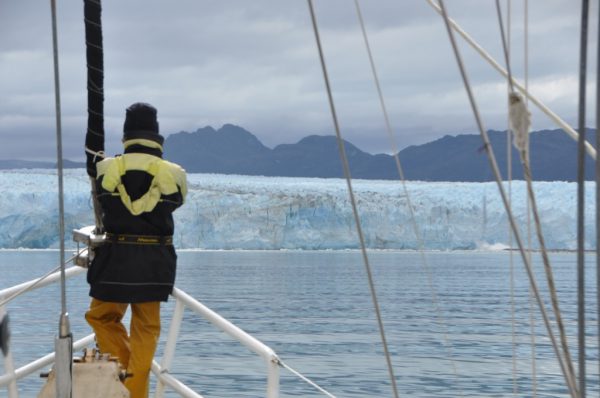
After Ladrillero’s voyage, interest in the Strait dwindled. Some people even said that it must have become blocked by volcanic activity. And then up popped Francis Drake, the English privateer. He appears to have had no trouble in finding the Strait, and he passed through it in just seventeen days. Then, after having been blown south in a storm (and having inadvertently discovered that there was an end to the South American continent) he sailed north up the coast and ransacked the Spanish colonies.
Drake penned an account of his adventures but he was of no mind to share the geographical details; but it was on account of Drake that Pedro Sarmiento was despatched to find and explore the Strait – and not only the Strait but those other channels which had caused such problems for Ladrillero. And Sarmiento was specifically ordered to keep a daily record of his discoveries. And he did so.
Sarmiento was the first man to give a detailed description of the Chilean channels and the Magellan Strait; and his original, 450 year old account, bound in red leather, still exists!
Little would be known about the origins of Pedro Sarmiento but for the fact that he ran foul of the Spanish Inquisition. Born in Bayonna, on the Atlantic coast of Spain, in about 1532, Sarmiento fought for his king at the age of eighteen and then, five years later, sailed to the New World to seek his fortune. After spending some time in Mexico and Guatemala (almost as a modern-day backpacker might), in 1557 he travelled to Peru – and it was here that he ran up against that extremist religious organisation whose nearest modern equivalent is Al Queda. Found guilty of telling an old woman that he knew how to make a love potion, Sarmiento was sentenced to attend mass, in the cathedral at Lima, stripped naked. After that he was to be perpetually banished from the Indies; and until his departure he was to be imprisoned in a monastery and made to fast on Wednesdays and Fridays.
Seemingly, Sarmiento had made an enemy, and that enemy had influence – but, happily, he had also made a friend. He was now in the employ of the Viceroy of Peru, and that gentleman was able to obtain a commutation of the sentence: Sarmiento could stay. Even so, ten years later he was in trouble again.
This time he was accused of owning two magic rings with which to practice necromancy. It is clear from his testimony that the rings evidently came from an astrolabe, or something similar, but the zealots found him guilty anyway.
Once again, the Viceroy intervened. By now our boy was surely very much in that person’s debt – and that just might be how he landed himself with the job of going where no man had successfully gone in many a long year, in pursuit of the English pirate.
Happily, he was the ideal man for the undertaking.
According to Sarmiento, Don Francisco de Toledo, Viceroy of Peru, had already sent ships in pursuit of “Francisco Draquez”, and when they couldn’t find him it was assumed that the enemy must be heading for home by the way that he had come – via the Straits. Thus, for the security of the empire, it became imperative that this passage be rediscovered.
“Pedro Sarmiento, to serve His Majesty, accepted the commission, notwithstanding many things which might have made him decline. But as his habit always was to risk his life in the service of his King and Earthly Lord, it was not for him to turn back nor excuse himself, for fear of death nor of the dangers that were notorious, nor because it was a service from which all others turned away.”
Whatever his good and bad points might have been, Sarmiento was certainly not guilty of self-effacement.
And so Sarmiento set out – and in a ship which, it soon became clear, was on the point of sinking. But he resolved that problem. He fixed the leaks and mended the sails, and with his consort – captained by a man most unwilling to play this game – he went south.
Although Ladrillero appears to have left no written account of his adventures he had evidently passed along a certain amount of information, for having travelled south Sarmiento turned in towards the coast at just the right latitude to discover a gulf – a deep bay, cluttered with islands, which gave access to the network of channels. This place he named The Gulf of Trinidad. The one to the north is called the Gulf of Ladrillero. Trinidad offers a much more direct route into the channels, and I suspect that Sarmiento already knew this.
Having found a reasonably safe place to anchor the two ships, Sarmiento spent the next few weeks exploring the channels in his ship’s boat – and, as ordered by the Viceroy, he kept a record of his activities; and if you are actually sailing along the channels which he discovered it is sometimes possible to recognise his descriptions. (But it’s a shame that the Viceroy didn’t think to send along an artist…)
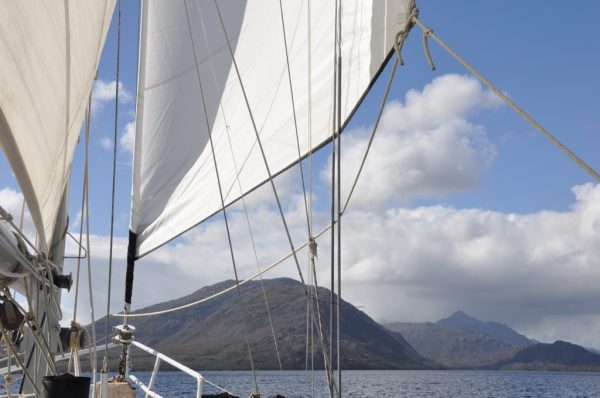
Eventually, Sarmiento reached the Straits of Magellan; and having found the Strait – and having lost his consort, whose cowardly captain had done a bunk – he proceeded along it and then sailed north to Spain. Thereafter, having been taken in by his own aggrandisement (as so many people are, in this age also), and having mistaken his own rabid devotion to his god for God’s favour (as so many people do), he gave a glowing account of the region, making it sound like the perfect place to live, and he took it upon himself to founded a colony in the Straits.
The purpose of the proposed settlement was to prevent English ships from navigating here. Ah, the irony…! Once again, Sarmiento put himself wholeheartedly into this campaign, and in the course of two years he wasted a sum of money equivalent to that of sending a man to the moon and condemned several hundred people to death from starvation, forcing them to remain here when they begged him to abandon the project. And all the while, had the English wanted to raid Peru again they could have gone via Drake’s newly discovered passage, just a little bit further to the south.
By the time the next dastardly English privateer passed this way Sarmiento had gone back to Spain and there were just sixteen people left alive in the colony. And that dastardly bastard – Thomas Cavendish by name – took just one of them aboard; and a year later, when another English ship came this way, there was only one colonist left.
But this is all by the by. Sarmiento was an arrogant megalomaniac; but he was also the man who first described the channels and the Magellan Strait, and it is only right and proper that his name be given to the tallest mountain in the region and also to a channel. And it was that channel – the Canal Sarmiento – that Mollymawk was now following. So, having explained the significance of the man and his voyage, let us turn back the page to that arrival on the unknown coast of Patagonia.
map
Having arrived in the gulf which he named for the Holy Trinity (or Trinidad), Sarmiento proceeded to the back of this bay, and here he found a wide channel which he named, accordingly, the Brazo Ancho. (This channel is nowadays known, even in Spanish, as Canal Wide – because that’s how it was charted by the Admiralty, who used Sarmiento’s names but in English translation.)
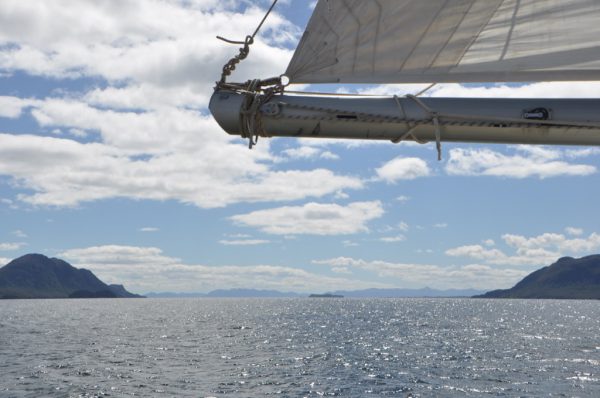
Turning right and sailing south-west down the channel, Sarmiento eventually found another gulf, or opening to the ocean – and this one he named Canal Concepcion.
The bizarre intertwining, on the Patagonian landscape, of Roman Catholic names and the names of 19th century English politicians is, I think, rather charming… The next gulf down is called the Nelson Strait, and between the two we have bays, islands, and inlets called Madre de Dios (Mother of God), Salvation, St Andrew, and Chatham, Hanover, Pitt, and Peel. There are also a few Italian and German names dating from the late 19th century, plus some places named for Chilean naval commanders.
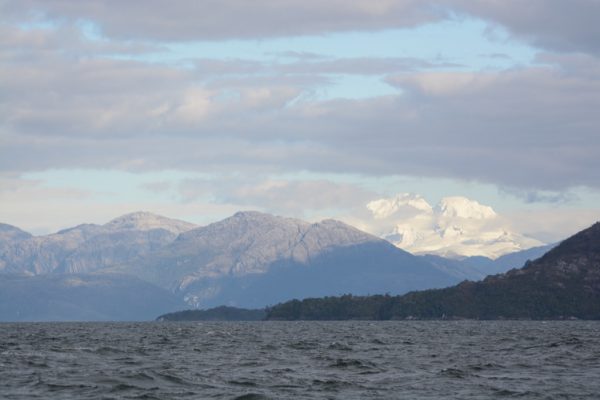
Having explored the Canal Concepcion – and having jolly nearly been swamped and drowned whilst messing about in an open boat on this perilous ocean shore – Sarmiento and his men returned to the ships; and then they made another voyage, this time hoping to travel via the channels all the way into the Straits of Magellan. The commander was certain that they would be able to do this without putting out to sea.
Had he heard that Ladrillero had achieved this aim, or was he just so devout that he believed that God would give in to his demands?
“Pedro Sarmiento set out on Tuesday, the 29th of December 1579, with Anton Pablos and Hernando Lamero, pilots, and twelve men, in the boat “Nuestra Senora de Guia“, with provisions for ten days.
They left to ascertain whether there was a channel by which the ships might be taken through safely without having to return to the high sea.
They went along a channel which they named Canal Innocentes, and then they found a narrow stretch which they named after their boat – and thus is it known today, as the Guia Narrows.
Then Sarmiento describes arriving at the mouth of a fiord now known as the Peel inlet. He describes the islands in the adjacent channel, and then he describes a bay:
“In this part, on the east coast, which is on the left hand, there is a large bay with much depth at the entrance. Near the seaweed there are six fathoms, and within seven, eight, and nine, sand and ooze. It is entered by the west and has an outlet to the south. It is surrounded by sandy beaches and seaweed. In the south channel there are ten fathoms, gravel. We called this bay Bahia Buena, or Puerto Bueno.”
Good Bay or Good Port is hardly an imaginative name – but in this part of the world, good ports are as rare as balmy days.
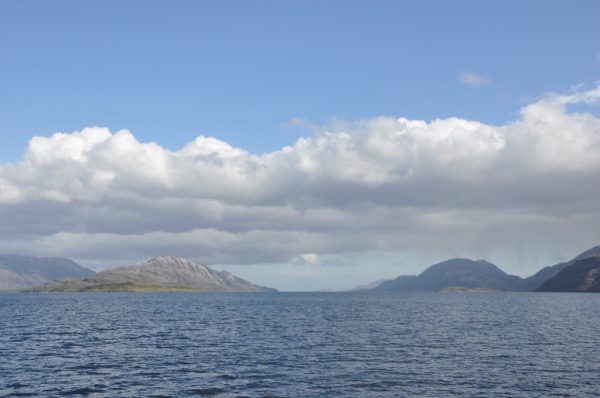
From this place Sarmiento continued south along the channel which now bears his name. When he reached the place which is now called Paso Farquar he continued along his direct line route. Unbeknownst to him there is a deeper and wider, safer route which is to be found by deviating along Farquar and then continuing south; but in the end it comes to the same thing – he eventually arrived at the foot of a big, snow covered mountain. For some reason, he didn’t think to name it, and so Skyring called it Burney.
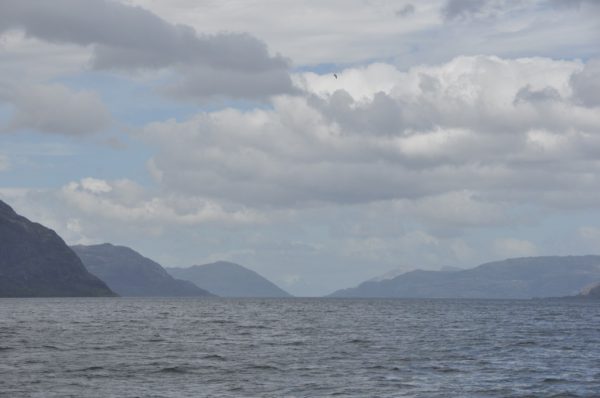
Sarmiento was now in the vicinity of Isla Jaime – that island where we spent five days while the wind blew hard from the north. Here, as we have seen, the channel does a U-turn; and Sarmiento, having taken a brief look, decided that was an Ancun Sin Salida – a Corner with No Exit. Some historians say that he recognised it as a place explored and described by Ladrillero, but although the town council in Puerto Natales have latched onto the idea that Ladrillero explored this region I have not been able to find the original source for this idea.
Having failed to find a way through, and being low on provisions, Sarmiento was obliged to turn back. He still believed in the existence of a channel through to the Straits, but, for various reasons, he preferred to head out to sea and find the entrance which Magellan and Drake had used.
And so he did.
And so it was left to William Skyring, some three hundred years later, to find and chart the remainder of the route through the Pacific channels.
Like us, Skyring was travelling north; but unlike us, he didn’t have an engine so he couldn’t pop into the little coves which are nowadays used by small craft. Even so, he was able to use that Good Port which Sarmiento was so taken with.
“In the evening, with the assistance of the boats, we moored in Schooner Cove, Puerto Bueno …
While we remained, a plan was made. … To the southward [this should read northward] is Lear Bay, affording anchorage but not to be chosen when such an excellent haven as Puerto Bueno is near. The south extreme of Lear Bay forms the north point of Puerto Bueno, and a few hundred yards south of that point is Rosamond Island, which is low and pointed. Four hundred yards south-south-east of this is a small round islet, bold to on every side; and between this islet and a low point … is the widest channel to the anchorage. Sarmiento, indeed, most appropriately named it Puerto Bueno.
It has both an inner and an outer port, the depth of water throughout is from nine to six fathoms, and any position in either I consider safe; but excepting that it affords better shelter, it differs in no respect from other anchorages in these regions. Wood and water are generally found in abundance near them all; fish may be caught; geese, ducks, shags, and steamers may be shot, and shell-fish gathered. The country, also, has the same appearance and is of a similar nature, for if you force a passage through the woods it is over fallen trees and moss; if you walk over clear flat ground, the place is found to be a swamp; and if you ascend the hills it is by climbing over rocks partially covered with spongy moss.”
When I read stuff like that I can almost picture the man plodding along beside us as we battle our way through the scrub and scramble up the rocks. Nothing has changed, Skyring! All is as you left it!
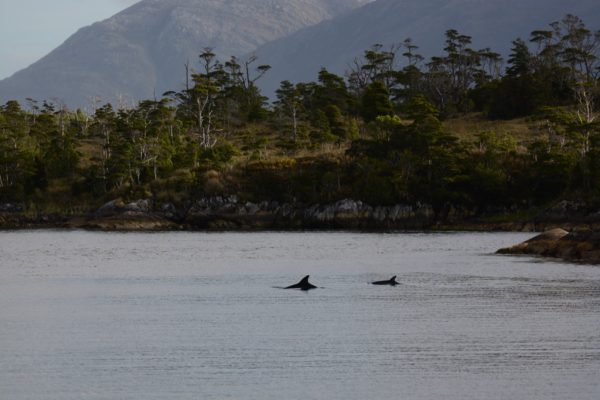
But Sarmiento and Skyring both omitted mention of the dolphins, which surely must have foraged, then as now in the bay. As we entered, their great-great-descendants came rushing to greet us.
I tried to picture Sarmiento setting up camp for the night with his men, but my knowledge of 16th century Spanish attire is a little hazy. So then I pictured the sailors from the Adelaide rowing ashore to cut wood. They, too, were mere ghosts in my imagination – men in indigo-dyed canvas smocks, smoking clay pipes. But then I recalled that Edward Allcard also came here – and, of course, I had no trouble picturing his little yacht, Sea Wanderer, anchored close by.
The sun fell down below the level of the clouds, and for a little while – for perhaps half an hour – the Good Port was bathed in sunshine, and it seemed a friendly hospitable place where there might be a village. Then night fell, and the temperature with it; and in the blackness of the night Mollymawk was all alone in the still, silent bay.

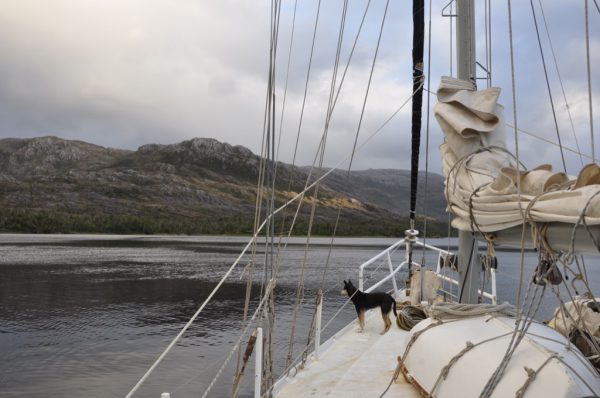
What a great read! Thank you!